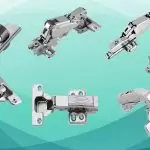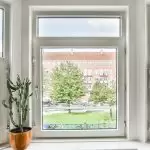Hinges are like connectors that let things rotate around a fixed point, allowing only one type of movement. It’s a bit like a spinning shaft in a hole. They’re most often used for doors, boxes, furniture, and more. Each hinge design suits different needs, and you can even make custom ones if required. So, hinges are all about providing the right kind of movement for various objects.
Post your Requirement
Types of Hinges
- Commonly used on doors and windows.
- Consists of two metal plates connected by a pin.
- Versatile for various applications.
Glass Door Hinges:
- Designed for glass doors.
- Ensure smooth opening and security.
- Types include pivot hinges, patch fittings, and shower door hinges.
Stainless Steel Hinges:
- Made from durable, corrosion-resistant stainless steel.
- Ideal for outdoor, high-moisture, and industrial use.
- Available in different sizes and styles.
Cabinet Hinges:
- Specifically for cabinet doors.
- Enable smooth open and close motions.
- Come in various styles and sizes.
- Hidden when doors or cabinets are closed.
- Offer a sleek, modern look.
- Suitable for contemporary designs.
Continuous Hinges:
- Also called piano hinges.
- A long strip of metal ran the door’s length.
- Provide stability and security for heavy-duty use.
Ball Bearing Hinges:
- Contains ball bearings between metal plates.
- Allow smooth rotation, reducing friction.
- Commonly used in heavy-duty applications like commercial doors.
Application Of Hinges
Hinges play diverse roles across industries. In furniture, they ensure the functionality and design of items like kitchen cabinets and office desks. In construction, hinges are pivotal for doors, windows, and gates, contributing to safety and architectural aesthetics.
The automotive sector relies on hinges for reliable operation in car doors, compartments, hoods, and trunk lids. The medical field utilizes hinges in adjustable beds, operating tables, and medical cabinets, demanding smooth and reliable function. Aerospace applications span cabin doors, cargo compartments, and control surfaces, requiring high-specification hinges that withstand air travel stresses. This versatile component assures secure rotation, underpinning modern safety, privacy, and convenience standards across various industries.
Factors to Consider When Purchasing Hinges
Factors to consider when purchasing hinges are stated below:
- Load: When purchasing hinges, the load they need to bear is a critical consideration. This load not only includes the weight of the moving part but also external and dynamic forces. Moreover, the door’s center of gravity can exert torque on the hinge, potentially leading to sagging in wide and heavy doors. Properly specifying the load requirements ensures the hinge’s dimensions and materials are suitable for the application.
- Free Body Diagram: Understanding the required movement of the hinge is essential. Some applications demand limited angular movement, while others may need full 180° or 90° rotations. Different hinge types are available to accommodate these needs. The hinge’s orientation, whether it’s right-handed or left-handed, also plays a crucial role, especially in relation to the door’s swing and type.
- Installation: The method of fastening hinges to moving and fixed parts is a practical consideration. Depending on the service and load requirements, hinges can be welded, bolted, or screwed onto frames. Additionally, hinges come with various mounting options, such as surface, concealed, flushed, or overlayed, which should align with the application’s needs.
- Aesthetics: For hinges used in furniture and doors, aesthetics are often a key factor. Some hinges are designed with decorative elements, as seen in butterfly and strap hinges. In contrast, concealed hinges maintain a continuous and uninterrupted look, making them suitable for achieving a sleek appearance.
- Hinge Corrosion Resistance: The environment in which the hinge will be used influences material selection. Stainless steel is ideal for applications requiring corrosion resistance and high strength, especially in salt-prone areas. Plastic hinges offer corrosion resistance without the same strength. Galvanized steel is a cost-effective alternative to stainless steel. Brass and bronze hinges are corrosion-resistant and add an attractive touch, making them suitable for decorative purposes.
- Additional Features: Hinges often come with special features to serve specific functions. For example, some hinges incorporate springs and pneumatic dampers for controlled movement. Hinges can also have multiple features, such as pins, grease fittings, bearings, bushings, or screw covers, enhancing their utility for diverse applications. When purchasing hinges, considering these factors ensures you select the right hinge for your specific needs, promoting longevity and functionality.
Top Brands Selling Hinges
Here we have listed the brands selling hinges:
- AKS
- Atlantic
- BTL
- CNR
- DORHAWK
- Dorma
- Dortex
- Ebco
- EPCA
- FGV Hindware
- Godrej
- Hafele
- Hettich
- Inox
- IPSA
- Kaff
- KBI
- Meltron
- Met Craft
- Ozone Overseas
- S N Brothers
- Samsung IREX
- Sifon
- Slimline
- Supreme Hinges
- Suzu
- Taiton
Conclusion
Hinges are like helpers at home, working on doors, cabinets, and toy boxes. In big industries, especially in places like chemical plants, they’re super important for keeping large containers safe. You can pick different styles and materials, like stainless steel or brass, for your doors or cabinets. We hope our blog helps you choose the right hinge for what you need.
FAQs
Q-1. What are the common types of hinges?
A-1. Common hinge types include butt hinges for doors, piano hinges for long, continuous support, and European hinges for cabinet doors.
Q-2. How do I determine the right hinge size?
A-2. Measure the door or lid’s thickness and the required load-bearing capacity to select an appropriate hinge size and material.
Q-3. What lubricant should I use for noisy hinges?
A-3. To stop noisy hinges, use silicone spray or a light machine oil. Put a little on the hinge and remove extra to keep it clean.























Post A Comment